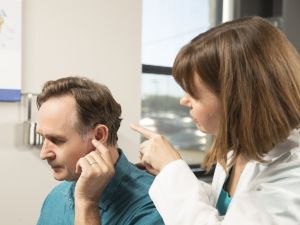|
www.HealthyHearing.com |
Hearing loss symptoms
By Joy Victory, managing editor, Healthy Hearing Last updated on: September 8th, 2025 The symptoms of hearing loss depend on the type of hearing loss you have—and the severity. Both volume and clarity of sound will be affected. Key points:
General symptoms of hearing loss
understand is a common symptom of hearing loss. Hearing loss usually develops slowly, gradually getting worse over the course of several years. People who work in noisy jobs or have a family history of hearing loss may notice these symptoms become problematic earlier in life. You may experience all or just a few of these scenarios:
Symptoms by hearing loss type:In addition to the general symptoms mentioned above, a person may experience more specific symptoms. This is dependent on what kind of hearing loss you have. Some types are more common among older adults, whereas others start in childhood or early adulthood. There are many types of hearing loss with unique symptoms, including:
Most common: Hearing loss from inner ear or nerve damage (sensorineural)The most common type of hearing loss is sensorineural hearing loss, which is caused from damage to the delicate hair cells in the inner ear and/or the nerve pathways that deliver sound to your brain. About 90% of people with hearing loss have this type, and it has a wide range of causes. Volume and clarity are affectedSensorineural hearing loss is usually gradual—you don't wake up overnight not being able to hear. Instead, you slowly lose the ability to hear. Both how loudly (volume) and how clearly (clarity) you perceive sound are affected. You might also experience a phenomenon known as recruitment, which causes some louder sounds to be uncomfortable to listen to. For example, you once loved fireworks shows, but now find the booming sounds nearly unbearable. High-frequency hearing loss symptoms.jpg) One of the more common types of sensorineural hearing loss is high-frequency hearing loss, which appears as a "ski slope" pattern on an audiogram. Many people who have presbycusis, a type of age-related hearing loss, develop this kind of hearing loss. It results in the reduced ability to hear things like:
Symptoms of noise-notch hearing lossSimilar to high-frequency hearing loss, noise-notch hearing loss means you can't hear certain high-pitched sounds very well (such as children's voices). But unlike high-frequency hearing loss, you may still hear very high-pitched sounds (birds or beeps). This type of hearing loss is associated with noise-induced hearing loss, especially loud gun blasts. For example, hunters who develop shooter's ear often have a noise-notch pattern of hearing loss. Symptoms of 'cookie-bite' hearing loss (mid-range frequency loss)A more rare form of hearing loss, "cookie-bite" hearing loss (which gets its name from its distinctive pattern on an audiogram) is when a child or adult has trouble hearing sounds in the mid-range frequencies. These are sounds that are neither particularly high-pitched nor low-pitched. As you can imagine, this includes many common sounds, making everyday situations like talking to friends or listening to music challenging. Generally people with this kind of hearing loss will realize they can easily hear things like squealing alarms or booming thuds, yet struggle to hear speech or music at what are seemingly normal volumes for other people. Symptoms of low-frequency loss (reverse-slope)Rarer still, reverse-slope hearing loss is essentially the opposite of high-frequency hearing loss. Symptoms include finding men's voices harder to hear than women's or children's voices, struggling to hear people on the phone but not so much during face-to-face conversations, and inability to hear environmental sounds that are low-pitched, such as the bass in music or thunder. A person with reverse slope hearing loss also might seem unusually sensitive to high-pitched sounds, too. Sometimes, Meniere's disease can cause this type of hearing loss in the earlier stages of the disease. Conductive hearing loss symptoms
what's causing your hearing loss. About 10% of people with hearing loss have conductive hearing loss, which means that their inner ear works fine, but their outer or middle ear isn't working normally for some reason (causes can range from a severe earwax blockage to head trauma). Most other types of permanent conductive hearing loss are detected at birth or soon after. In adults, when it does occur, it tends to develop must faster than sensorineural hearing loss, and depending on the cause, may be reversible. The symptoms will be similar to general hearing loss symptoms, just occurring at a faster rate. For example, if you are in a bad car accident and notice you're struggling to hear speech, and feel like your own voice sounds odd to you, you may have conductive hearing loss. Any pain, pressure, or strange odor in your ears are other clues you may have a condition that causes conductive hearing loss. Symptoms of sudden hearing lossIn rare cases, a person can develop sudden hearing loss, usually in one ear. It may be conductive or sensorineural. The symptoms and signs are generally pretty obvious—you suddenly can't hear well out of one ear. But if you have a bad cold or ear infection, it may be hard to tell if it's just temporary congestion or actual hearing damage from the virus or bacteria. In some cases, people hear a loud pop and then lose their hearing. The affected ear may feel stuffy, or "full," and a person may feel dizziness or hearing ring in their ear. Because prompt treatment is key, act fast if you experience sudden hearing loss. Flat hearing loss symptomsA conductive hearing loss can present as a flat hearing loss, muffling hearing across the frequency spectrum (all pitches). However, sensorineural hearing loss can also sometimes cause a loss of hearing across all pitches. Symptoms of single-sided deafnessFor people with severe to profound hearing loss in one ear, you may notice it's harder to tell where sound is coming from, known as localization. You also may have a hard time focusing on a single source of sound in a noisy environment, such as at a party. You might also struggle to discern how loud a sound is, because your brain relies on sensory input from both ears to detect volume. People with single-sided deadness also experience something known as the "head shadow" effect, which makes high-pitched sounds harder to hear. Temporary noise-related hearing loss symptomsTemporary hearing loss is often related to exposure to loud noises, such as gunfire, fireworks, concerts or exposure at work. Temporary hearing loss is characterized by a temporary threshold shift (TTS), meaning that hearing is temporarily worse following loud sound exposure but may improve within one to two days. It's often accompanied by tinnitus, or ringing in the ears. It can last for only a few hours or several days before hearing returns to normal. Symptoms of hearing loss in childrenHearing loss in children is usually detected with the help of a newborn infant hearing screening soon after birth. Some parents also may be able to detect hearing loss in their child if it's not caught at birth. Symptoms of hearing loss in children include:
Next stepsIf you suspect hearing loss in yourself, your child or someone close to you, use our directory of consumer-reviewed clinics to read reviews of hearing specialists or audiologists near you. The sooner you seek help, the better your outcome will be. Joy Victory, managing editor, Healthy Hearing
You are reading about: Related topics
More information about hearing aids, hearing aid brands, assistive devices and tinnitus. Featured clinics near me
Earzlink Hearing Care - Reynoldsburg Find a clinicWe have more hearing clinic reviews than any other site! Related contentThe Healthy Hearing Report |
|
www.HealthyHearing.com |
Hearing loss symptoms
By Joy Victory, managing editor, Healthy Hearing Last updated on: September 8th, 2025 The symptoms of hearing loss depend on the type of hearing loss you have—and the severity. Both volume and clarity of sound will be affected. |



 Joy Victory has extensive experience editing consumer health information. Her training in particular has focused on how to best communicate evidence-based medical guidelines and clinical trial results to the public. She strives to make health content accurate, accessible and engaging to the public.
Joy Victory has extensive experience editing consumer health information. Her training in particular has focused on how to best communicate evidence-based medical guidelines and clinical trial results to the public. She strives to make health content accurate, accessible and engaging to the public.